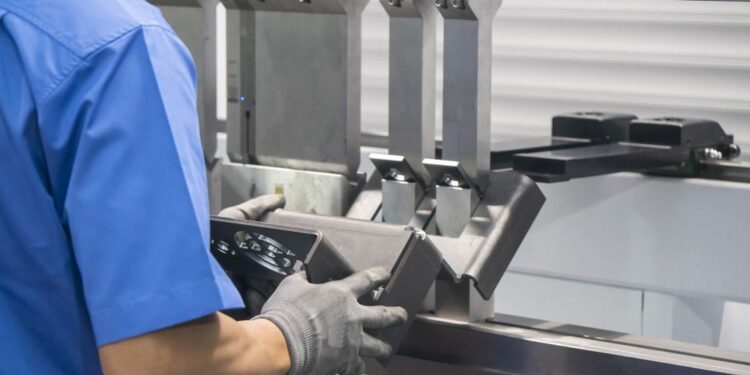Operating a metal brake, whether a metal bending brake or a planishing hammer, requires precision and attention to detail. While these tools are invaluable for shaping and bending metal, it’s crucial to prioritize safety to prevent accidents and protect yourself and your workpiece. This article will explore important safety precautions to consider when operating a metal brake. Following these guidelines can ensure a safe working environment and achieve successful results in your metalworking projects.
Wear Appropriate Safety Gear:
Before using a metal brake, it’s essential to wear the appropriate safety gear to protect yourself from potential hazards. This includes:
- Safety glasses or goggles: Shield your eyes from flying debris, metal fragments, or sparks that may occur during the bending or shaping.
- Protective gloves: Wear heavy-duty gloves that provide ample hand protection against sharp edges or potential pinching hazards.
- Hearing protection: If you operate a metal brake that generates loud noise, such as a planishing hammer, wear earplugs or earmuffs to protect your hearing.
- Protective clothing: Avoid loose-fitting clothing or jewelry that could get caught in the machine. Wear long sleeves, pants, and closed-toe shoes to protect your skin from potential cuts, burns, or impact.
Familiarize Yourself with the Machine:
Before operating a metal brake, familiarize yourself with its specific features, controls, and safety mechanisms. Read the user manual thoroughly to understand the machine’s capabilities, limitations, and recommended operating procedures. Ensure you have received proper training or sufficient knowledge of the metal brake’s operation.
Maintain a Clean and Organized Workspace:
A cluttered or disorganized workspace can increase the risk of accidents. Keep your work area clean and organized, free from unnecessary tools, debris, or obstacles. This helps prevent tripping hazards and allows for better maneuverability around the metal brake.
Secure the Workpiece:
Ensure the workpiece is securely held or clamped before operating the metal brake. This prevents unexpected movement or slipping during the bending or shaping process. Use appropriate clamps or fixtures that provide stability and maintain a safe distance between your hands and the bending area.
Use the Correct Tooling and Accessories:
Always use the correct tooling and accessories recommended for your specific metal brake. Using inappropriate or damaged tooling can compromise the safety and accuracy of the bending process. Ensure the tooling is properly aligned, tightened, and secured to prevent accidents or unexpected movements.
Start with Small Bends and Gradually Increase:
When working with a metal brake, especially if you are new to using it, start with small bends and gradually increase the complexity or severity of the bends. This lets you become familiar with the machine’s operation and ensures better control and accuracy. Rushing into complex bends without sufficient experience can lead to mistakes or accidents.
Apply Proper Technique and Force:
Follow the recommended techniques for operating the metal brake, including proper hand placement, body positioning, and force application. Use smooth and controlled movements when bending or shaping the metal, avoiding sudden or jerky motions that can compromise the accuracy or safety of the process.
Be Mindful of Sharp Edges:
Metal edges can be sharp and pose a risk of cuts or injuries. Take extra care when handling metal sheets or workpieces with sharp edges. Use appropriate tools, such as gloves or deburring tools, to smooth or remove sharp edges before bending or shaping.
Avoid Overloading the Machine:
Each metal brake has its specified maximum capacity. Avoid overloading the machine by exceeding the recommended thickness or bending limits. Overloading can strain the machine, compromising its performance and potentially causing damage or accidents. Always check and adhere to the manufacturer’s guidelines for the maximum bending capacity of your metal brake.
Maintain Focus and Concentration:
When operating a metal brake, it’s crucial to maintain focus and concentration. Avoid distractions or multitasking while working with the machine. Any lapse in attention can lead to errors or accidents. Stay present and fully engaged in the bending process, ensuring you know your surroundings and the machine’s operation.
Turn Off the Machine when Not in Use:
Remember to turn off the metal brake and disconnect it from the power source when taking breaks or finishing your work. This prevents accidental activation and reduces the risk of injuries or damage.
Regular Maintenance and Inspections:
Perform regular maintenance and inspections on your metal brake to ensure its optimal performance and safety. Clean the machine, lubricate moving parts as the manufacturer recommends, and inspect for any signs of wear, damage, or loose components. If you notice any issues, address them promptly and avoid using the machine until the necessary repairs or replacements have been made.
Seek Professional Assistance if Needed:
If you encounter complex or unfamiliar metal bending tasks or are unsure about the proper operation of the metal brake, seek professional assistance. Consulting with an experienced metalworker or technician can provide valuable guidance, ensuring both your safety and the successful completion of your project.
Conclusion
Safety should always be the top priority when operating a metal brake. At Eastwood, we emphasize the importance of following safety precautions to protect yourself and your workpiece. Adhering to these guidelines can minimize the risk of accidents and injuries, ensuring a safe metal bending experience.
If you encounter complex projects or feel unsure about a specific bending task, don’t hesitate to seek professional assistance. Consulting with experienced metalworkers or contacting our knowledgeable team at Eastwood can provide valuable guidance and ensure a safe and successful metalworking journey. Whether you’re a professional mechanic, a DIY enthusiast, or a restoration hobbyist, you’ll find everything you need at Eastwood. Our goal is to provide you with the right tools and supplies that enable you to achieve professional-level results without compromising on quality or breaking the bank.









